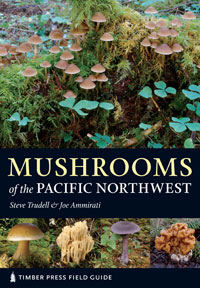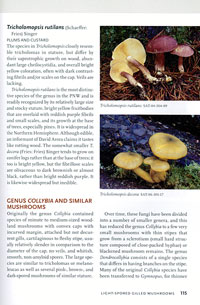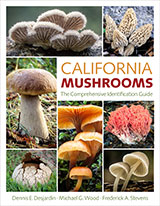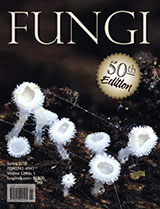Book Review
Mushrooms of the Pacific Northwest
If you are like many serious mushroomers, your shelves of mushroom books are already overloaded. Every new mushroom book must be evaluated: “Is this book worthy of my collection?” Let’s see.

At first inspection, it’s clear that the book is printed on quality paper, with a durable binding, and with an attractive design. The preliminary sections include information on ‘What are Mushrooms?’, ‘Guidelines for collecting’, ‘Ecology’, ‘Mycorrhizas’, ‘Mushroom poisoning’, and ‘Identification’. The end of the book has a very useful illustrated glossary and a section on types of mushroom poisoning.
As a field guide, the heart of the book is the descriptions and photographs of about 460 species of mushrooms and other fungi. Here, like most mushroom field guides, you will find the mushrooms grouped by macro-morphology and spore print color. There are keys to the 16 groups used by the authors, and keys to the genera in each group, but no keys to the species.
The descriptions are well written, as is the rest of the book. They are short, emphasizing important diagnostic characteristics and often include ecological and edibility information. Ideally, I would prefer to see more complete descriptions, but including longer descriptions in a book with this many species would have made a very large book and the authors had a page limit from their publisher. Ultimately I think their decision to include more species at the expense of longer descriptions was the right choice to make. In fact one of the principle strengths of this book is the large number of species included that you will not find in any other field guide. For example, there is no other North American field guide where you will find descriptions and photos of 25 species of Cortinarius!

The photographs, mostly by Steve Trudell, are excellent, far better than most field guides. The problem is they are presented much too small. Every mushroomer interested in buying this book would be willing to pay a bit more for a larger book with larger photographs. Obviously the publisher does not understand its audience for this book. It’s a shame the photographs are not presented in the size that their quality demands. (The senior author told me that the editor had made a verbal promise for larger photographs, but that was ignored after the sale of the publisher and the change of the editor.)
The genera or groups of mushrooms are given a few introductory paragraphs. Relationships to other groups are discussed and the characteristics that unite the group are enunciated. This is very useful in giving the reader a perspective on the group being discussed. The names used for the fungi are up-to-date and significant synonyms are noted. Common names are only given for the few species where common names actually exist. Thankfully the all too common, and regrettable, practice of making up “common names” was not done here.
This volume definitely deserves space on your mushroom book shelf; it’s a quality book that you will use often. If you are a mushroomer in the western United States, the book is an essential addition to your library.
Buy Mushrooms of Pacific Northwest
— Review by Michael Wood
— Scheduled to be published in Fungi


